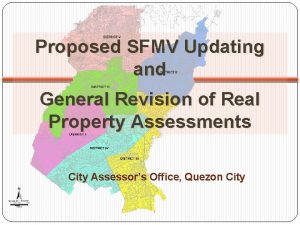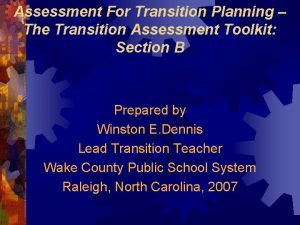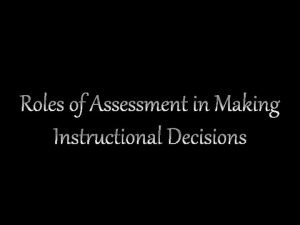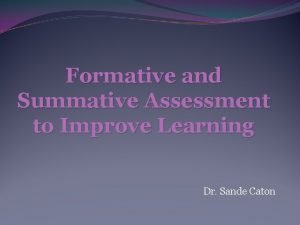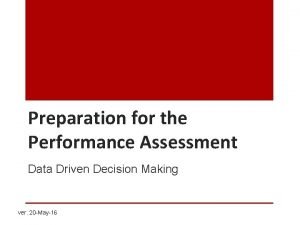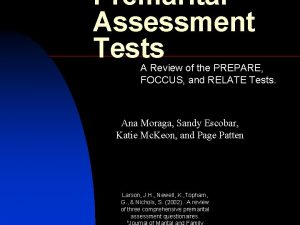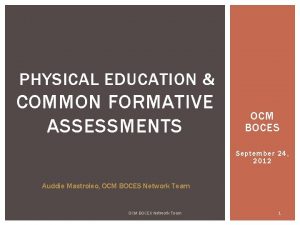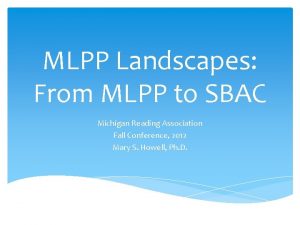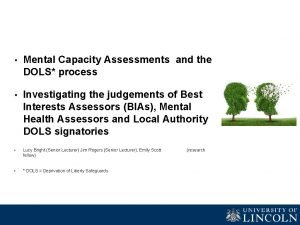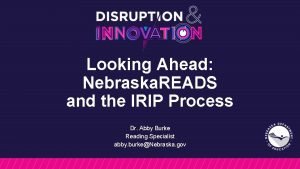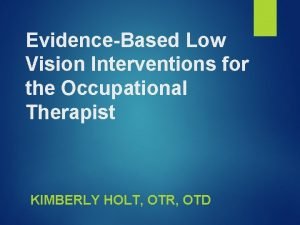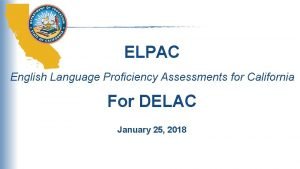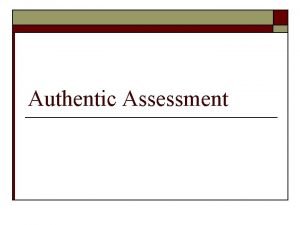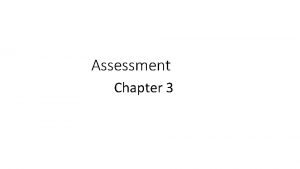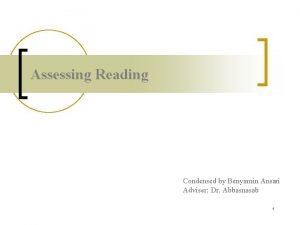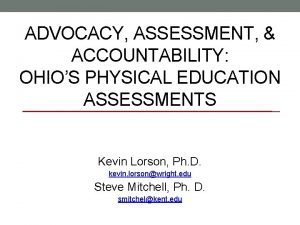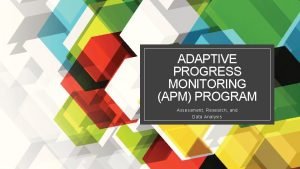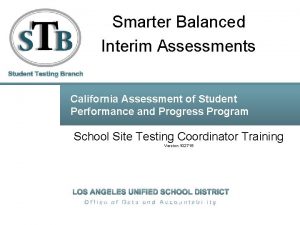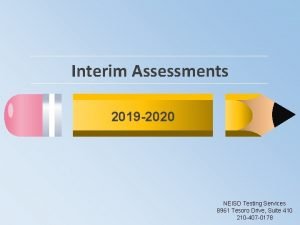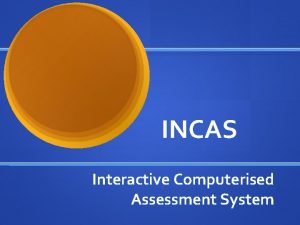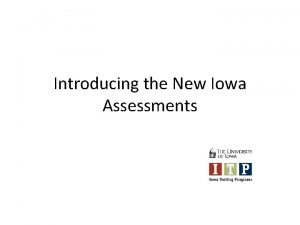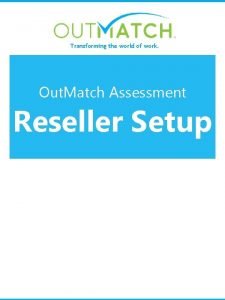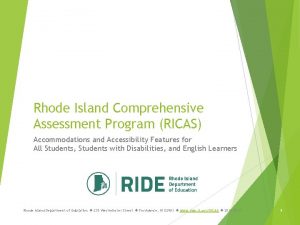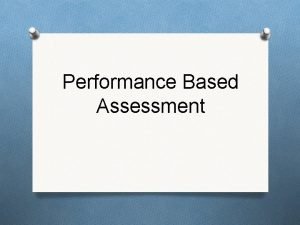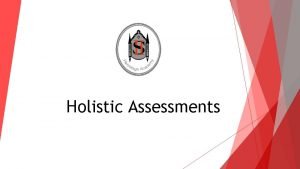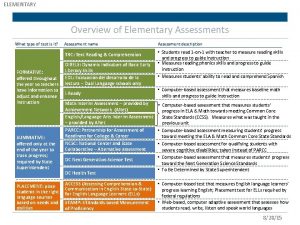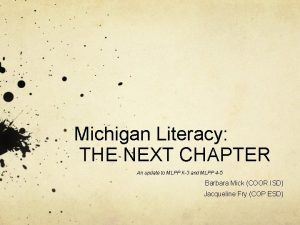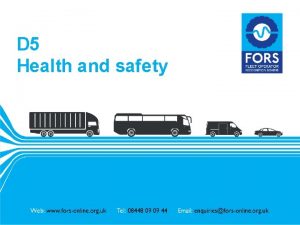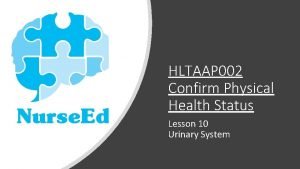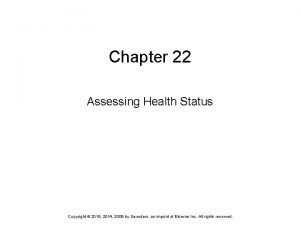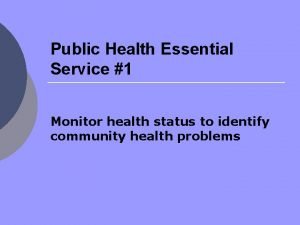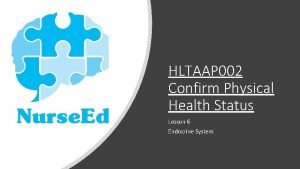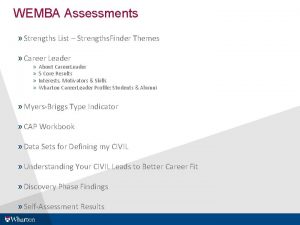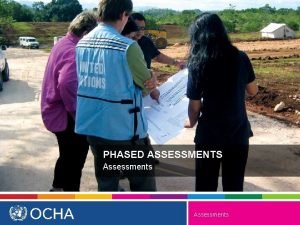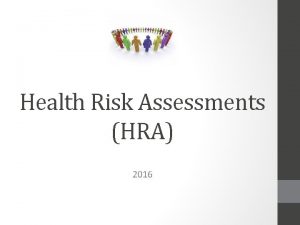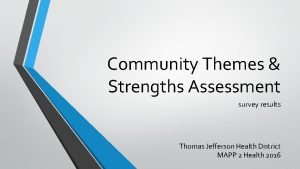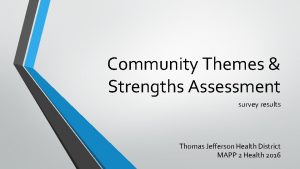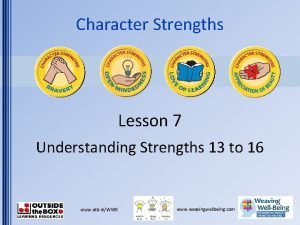Community Health Status and Community Themes Strengths Assessments
























































- Slides: 56

Community Health Status and Community Themes & Strengths Assessments November 19, 2010

What we heard from you To learn… • More about the MAPP process • Helpful information on partnering for our network • How to strengthen our regional community health planning committee • How to complete a CHSA and CTSA • How to obtain information on community assets • How community health workers can impact this process • How to incorporate and connect community themes & strengths into the CHSA • How to adapt assessments to meet specific public health issues such as those important to EMS “To get a complete understanding of how to implement the MAPP process in the best possible manner. ”

3

Traditional Data & Intervention • DATA: Sixty-four percent of adults are overweight or obese. • INTERVENTION: New worksite education programs to help employees improve diet and physical activity behaviors

MAPP Assessment Data & More Focused Intervention • CTSA: There are sidewalks and bike paths throughout the community, but residents do not feel safe using them. • LPHSA: The public health system is strong in monitoring health and health education but weak in mobilizing the community and developing improvement plans. • FOCA: New federal legislation may increase opportunities for economic development. Focused Intervention: Community coalition secures stimulus dollars and work with residents to improve the safety and accessibility of public parks and recreation facilities.

The Four Assessments • Forces of Change • Local Public Health System (NPHPSP) • Community Themes and Strengths • Community Health Status 6

Community Health Status Assessment Analyzes data about • Health status • Quality of life • Risk factors 7

Community Health Status Assessment 1. Convene a group of diverse community partners 2. Review results from other MAPP assessments 3. Select indicators of interest 4. Identify existing data sources 5. List missing data 6. Collect data 7. Organize and analyze data 8. Establish an updatable monitoring system 9. Evaluate and improve system 8

Community Health Status Assessment 11 Categories of Data • • • Demographic Characteristics Socioeconomic Characteristics Health Resource Availability Quality of Life Behavioral Risk Factors Environmental Health Indicators Social and Mental Health Maternal and Child Health Death, Illness and Injury Infectious Disease Sentinel Events 9

Sources of Data ü State or local databases ü Previously conducted health assessments or reports ü Partners who have access to data through their organizations ü Track down hard to find data ü Consider whether new sources of data need to be developed ü County Health Rankings 10

Clearinghouse Tools • Data worksheets • Sample surveys, also in Spanish • Assessment data presentation • Examples of CHSA reports 11

Community Themes and Strengths Assessment Identifies • Themes that interest and engage the community • Insights about quality of life • Community assets 12

Community Themes and Strengths Assessment Steps 1. Establish a subcommittee 2. Implement activities to identify community themes & strengths 3. Compile the results 4. Sustain community involvement 13

Community Themes and Strengths Assessment Three levels of information gathering should occur during the CTSA: • Open discussion to elicit community concerns, opinions, and comments in an unstructured way (e. g. community dialogues) • Insights regarding community quality of life – questions about quality of life in the community can identify specific concerns • A map of community assets. Asset Mapping is the process by which the capacities of individuals, civic associations, and local institutions are inventoried 14


Community Themes and Strengths Assessment Collect community input via: • Focus groups • Surveys • Brainwriting exercise • Windshield surveys • Photovoice • Town hall meetings • Informal discussions with community Important Tip: Have community members participate on planning committees 16

Community Themes and Strengths Assessment Focus on Assets • Opportunities vs. problems • Partners vs. “clients” Use Reflective Listening • Stop Talking • Listen Carefully • Repeat Back • Ask Questions to Probe for How’s and Why’s • Listen Again 17

Warren County, NJ 18

Warren County, NJ 19

Clearinghouse Tools • How-To Guide • Focus Group Guidelines • Photovoice Manual • Examples of CT&SA Reports • Asset Mapping Articles 20

Community Health Status and Community Themes and Strengths Assessments NACCHO Webinar November 19, 2010 Stephanie Welch Community Development and Planning Director Knox County Health Department stephanie. welch@knoxcounty. org (865) 215 -5297

Overview • • Which assessment should you do first? Assessment tools and processes Building in evaluation Lessons learned

81 74 63 83 11 22 03 19 95 17 41 57 38 68 39 20 51 79 24 35 55 36 91 East Tennessee Region 50 • 15 Rural Counties • Total population approx. 600, 000 02 31 52 88 26 58 01 47 18 73 33 32 06 54 15 05 62 70 Knox County 30 45 72 61 77 29 78 53 04 16 64 28 65 93 89 59 87 08 60 12 25 71 21 75 67 82 37 07 80 43 94 49 44 34 13 76 85 42 69 14 56 • One of six “metro” TN counties • Population 430, 000 90 86 46 10

MAPP Assessments: Where to start? • Monroe County – Community Health Status Assessment – Health Council wanted data for grant writing • Jefferson County – Local Public Health System Assessment – Health Council concerned about health care service gaps, considering opening a free medical clinic for uninsured • Cocke County – Community Themes and Strengths Assessment – Health Council wanted to build community engagement with an interactive dialogue about health assets and needs • Knox County – Simultaneous: Community Themes and Strengths and Community Health Status – Community Partners expresses “assessment fatigue” and requested that health department bring something to the table to initiate MAPP


Community Health Status Assessment: Monroe County • Step 1: Strategic Planning Director provided CHSA Orientation for Health Council and Graduate Students • Step 2: Health Council identified examples of data desired and data sources (agency, contact name) for each of the CHSA categories • Step 3: Students gathered and compiled data • Step 4: Students presented data report to Health Council • Step 5: Strategic Planning Director facilitated evaluation meeting – Missing data? – Usefulness of report? – Did the process work (For community members? For students? For faculty? For HD staff? )

Community Health Status Assessment: Knox County • Step 1: Form staff assessment team • Step 2: Assign data categories to staff • Step 3: Gather and compile data – Engage partners – existing data sources? – Weekly meetings to evaluate progress • Step 4: Develop report format and write report

Data Categories Section 1: Community Description Section 2: Access to Health Care and Coverage Section 3: Quality of Life Section 4: Behavioral Risk Factors Section 5: Environmental Health Indicators Section 6: Social and Mental Health Section 7: Maternal and Child Health Section 8: Death, Illness and Injury Section 9: Communicable Disease

176 sources of data and information • • Utility Board Area Planning Commission Chamber of Commerce Law Enforcement Agencies Transportation Planning Organization Parks and Recreation Office on Aging Etc



Community Health Status Assessment: Benefits • • #1: Data for grant writing #2: Data for program planning #3: Set bar for measuring outcomes #4: Help balance perception with reality – Both are important


Community Themes and Strengths Assessment: Cocke County • Step 1: Strategic Planning Director provided CTSA Orientation for Health Council • Step 2: Health Council identified methods for collecting data; decided on: – – Paper survey (quality of life priorities) Focus groups and interviews (needs and concerns) Group dialogue (underlying issues and assets) “Windshield” surveys (physical environment)

Community Themes and Strengths Assessment: Cocke County • Step 3: Meeting between Health Council and UT students • Step 4: Training on assessment methods • Step 5: Conduct assessment – Three months • Step 6: Report writing • Step 7: Report presentation at public meeting – Media coverage




Community Themes and Strengths Assessment Knox County • Step 1: Core staff determined methodology and designed instruments – Researched other models – Surveys, Focus Groups, Key Informant Interviews, Group Dialogue – Goal: Engage a large, representative cross-section of community • Step 2: Full-staff inservice; engage staff in: – Pilot test assessment methods – Assist in marketing and conducting assessments • Step 3: Revise assessment instruments • Step 4: Train staff and student partners to conduct assessments – Recording devices, meeting facilitation, interview techniques, etc. • Step 5: Provided presentations and facilitated group dialogue at 27 community meetings • Step 6: Conduct assessment – Three months

Assessment Methods • Focus groups: – A group of approx. 10 people asked about their perceptions, opinions, beliefs and attitudes towards health in Knox County – Open invitation, used incentives • Key Informant Interviews – Key informants have an above average level of knowledge/experience about the topic – Careful selection through committee process • Group Dialogue – Open conversation, guided by a few questions and a facilitator – Used existing meetings of groups and coalitions






Community Dialogues and Assessment Marketing • • • • Knox County Board of Health Knox County Commission Farragut Board of Mayor and Aldermen Knox County Board of Education Knoxville Local Emergency Planning Committee (LEPC) United Way of Greater Knoxville Smoke Free Knoxville Coalition East Tennessee Worksite Wellness Roundtable Council of Involved Neighborhoods (COIN) Senior Safety Task Force Engaging Boys & Men Task Force Community Coalition on Family Violence Greater Knoxville Nutrition Council Community Action Committee Board And more….

How was the information collected? • 3098 completed surveys • 9 focus groups/52 participants • 27 key informant interviews Farragut High School Library 11237 Kingston Pike, Farragut May 5 5 -6: 30 p. m. South Doyle Middle School Library, 3900 Decatur Road May 5 5 -6: 30 p. m. Cumberland Estates Recreation Center, 4529 Silver Hill Drive May 6 5 -6: 30 p. m. Howard Pinkston Branch Library, 7732 Martin Mill Pike May 12 5 -6: 30 p. m. Gibbs High School, in the Library, 7628 Tazewell Pike, Corryton May 13 6 -7: 30 p. m. Halls Branch Library, 4518 E. Emory Road May 14 6 -7: 30 p. m. Central High School, in the Library, 5321 Jacksboro Pike May 19 5 -6: 30 p. m. L. T. Ross Building, Multi. Room B, 2247 Western Avenue May 21 3 -4: 30 p. m. Carter Branch Library, 9036 Asheville Highway May 26 6 -7: 30 p. m. Pellissippi State Lamar Alexander Building, Room 104 10915 Hardin Valley Road May 28 5: 30 -7 p. m. West Knoxville Branch Library, 100 Golf Club Road, Knoxville May 28 6 -7: 30 p. m. Cansler Family YMCA 616 Jessamine Street, Knoxville June 1 5: 30 -7 p. m. Karns Branch Library, 7516 Oak Ridge Highway June 2 6 -7: 30 p. m. Farragut Branch Library 417 N. Campbell Station Road, Knoxville, June 30 5 -6: 30 p. m.

Community Themes and Strengths Assessment Knox County • Step 7: Transcribe focus group and interview recordings • Step 8: Data analysis • Step 9: Report writing • Step 10: Report editing • Step 11: More report writing…. .



Evaluation: Community Themes and Strengths • How closely does assessment participant profile reflect the profile of your community? • How did the process work for assessment participants? Staff? Students? • Is the data useful for its intended use (identifying strategic issues)?



Benefits: Community Themes and Strengths Assessment • Data very unique to community • Engages and excites community members at all levels • Results used for grant writing • Great way to involve staff and partners – Recorders, Facilitators, etc. • Perception IS reality – Need to meet people where they are

Lessons Learned/Advice • Keep MAPP Philosophy at forefront – – Community engagement and ownership Strategic thinking Local public health system focus Use Dialogue skills • The way the report is written is as important as the data it contains • Tap into existing resources – Health Department? Students? Health systems? United Way? Chamber of Commerce? – Use NACCHO MAPP Clearinghouse • Students require supervision and structure • Communications and marketing are critical

www. healthyknox. org www. naccho. org
 Formal assessment in reading
Formal assessment in reading Community health status indicators
Community health status indicators Roles of occupational health nurse
Roles of occupational health nurse General revision of assessments and property classification
General revision of assessments and property classification Formal vs informal assessment
Formal vs informal assessment Formative summative diagnostic
Formative summative diagnostic Physical fitness grade 9
Physical fitness grade 9 What is formative assessment
What is formative assessment Performance assessments examples
Performance assessments examples Premarital tests or assessments
Premarital tests or assessments Common formative assessment examples
Common formative assessment examples Process oriented rubric example
Process oriented rubric example Mlpp assessments
Mlpp assessments Six dols assessments
Six dols assessments Irip
Irip Ls&s low vision
Ls&s low vision Elpac
Elpac Cte technical skills assessments.azed.gov/student
Cte technical skills assessments.azed.gov/student Creative arts, grade 8
Creative arts, grade 8 Formative assessment cycle
Formative assessment cycle Traditional and authentic assessment similarities
Traditional and authentic assessment similarities Characteristics of psychological test
Characteristics of psychological test Reading assessment examples
Reading assessment examples Physical education
Physical education Adaptive progress monitoring
Adaptive progress monitoring Sat suite of assessments
Sat suite of assessments Lausd interim assessments
Lausd interim assessments Interim assessment tea
Interim assessment tea Writing analytical assessments in social work
Writing analytical assessments in social work Vdoe algebra readiness
Vdoe algebra readiness Informative assessment
Informative assessment Incas assessments
Incas assessments Florida assessments for instruction in reading
Florida assessments for instruction in reading Ddi assessment
Ddi assessment Aimsweb plus benchmark assessments
Aimsweb plus benchmark assessments Assessment strategies and tools
Assessment strategies and tools Iowa staewide assessment of student progress
Iowa staewide assessment of student progress Glba risk assessment template
Glba risk assessment template Thereselleraccount
Thereselleraccount Ricas graphic organizer
Ricas graphic organizer Characteristic of performance based assessment
Characteristic of performance based assessment Osde assessments
Osde assessments Next generation assessments examples
Next generation assessments examples Kentucky assessments biology
Kentucky assessments biology Holistic assessments
Holistic assessments Anet interim assessments
Anet interim assessments Rhode island comprehensive assessments system
Rhode island comprehensive assessments system Michigan literacy progress profile
Michigan literacy progress profile Common core ela assessments
Common core ela assessments Fors-online
Fors-online Datarich student assessments
Datarich student assessments Adult assessment
Adult assessment Health and social care component 3 health and wellbeing
Health and social care component 3 health and wellbeing Hltaap002 confirm physical health status
Hltaap002 confirm physical health status Chapter 22 assessing health status
Chapter 22 assessing health status Monitor health status
Monitor health status Lesson 6 employee health status
Lesson 6 employee health status



